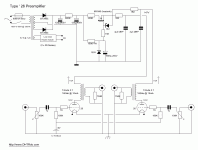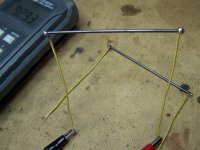Hi Rod,
Thanks.. Some time ago I stumbled on the same challenge: Only on filament winding on power transformer but wanting to use directly heated Triodes. Following "old school" diagrams I came upon this. Since the filament is grounded, there is no (audible) noise penalty when using LM317 as current source..
For completeness of the post I attached the diagram..
Rob
Thanks.. Some time ago I stumbled on the same challenge: Only on filament winding on power transformer but wanting to use directly heated Triodes. Following "old school" diagrams I came upon this. Since the filament is grounded, there is no (audible) noise penalty when using LM317 as current source..
For completeness of the post I attached the diagram..
Rob
Attachments
Since I am posting, also an idea for the bias resistor..
Use graphite!
De-wood a HB pencil and use the graphite rod as bias resistor. Sounds better to my ears than wire-wound resistors. Wattage about 10 Watts (although they can be heated until they glow bright red )
)
See for more how-to details on my site (Dutch), but pictures are more or less self-explaining..
Also on Troels site in English (I used his as reference..)
Rob
Use graphite!
De-wood a HB pencil and use the graphite rod as bias resistor. Sounds better to my ears than wire-wound resistors. Wattage about 10 Watts (although they can be heated until they glow bright red
See for more how-to details on my site (Dutch), but pictures are more or less self-explaining..
Also on Troels site in English (I used his as reference..)
Rob
Attachments
Rob, Works OK when the filament Regulator has dynamic output impedance much higher than the filaments (1.5 ohm). Crosstalk between L & R channels is degraded by leakage capacitance (or stability capacitors of voltage regulators). If you have a Turntable with a moving-coil cartridge, this high impedance must reach to 50kHz, to keep out crosstalk of scratches/defects!
What's the Tribute Transformer? Is it high performance?
What's the Tribute Transformer? Is it high performance?
Rod, thanks for elaboration! Clear as always..
Tribute high performance? Mwah... (sorry Pieter, could not resist )
)
Actually it was designed as a 2A3 1:2 step-up interstage. I use it in reverse.. It has excellent bandwith (up to 80khz, no saturation at low frequencies), has an amorphous core. Sound is very much okay..
Rob
Tribute high performance? Mwah... (sorry Pieter, could not resist
Actually it was designed as a 2A3 1:2 step-up interstage. I use it in reverse.. It has excellent bandwith (up to 80khz, no saturation at low frequencies), has an amorphous core. Sound is very much okay..
Rob
Hi Rob,
Are you really terminating this with 750 Ohms on the output as indicated in the schematic you posted? That would load the 26 with 3 kOhms...
Thomas
Actually it was designed as a 2A3 1:2 step-up interstage. I use it in reverse..
Are you really terminating this with 750 Ohms on the output as indicated in the schematic you posted? That would load the 26 with 3 kOhms...
Thomas
Hi!
I'm surprised, 3k seems like a very low load to me. I can see how that probably swamps out many properties of the transformer since the 3k dominates the load, so the inductance does not play that big of a role any more. Gain is also drastically reduced due to the loss across this load.
I can see how that equalises frequency response over a wide bandwidh, but I'd expect that it increases distortion considerably. Probably not as much at line levels but should be noticable.
I never liked the sound of stages with such a low impedance relative to the output impedance, that's why I'm surprised
Best regards
Thomas
I'm surprised, 3k seems like a very low load to me. I can see how that probably swamps out many properties of the transformer since the 3k dominates the load, so the inductance does not play that big of a role any more. Gain is also drastically reduced due to the loss across this load.
I can see how that equalises frequency response over a wide bandwidh, but I'd expect that it increases distortion considerably. Probably not as much at line levels but should be noticable.
I never liked the sound of stages with such a low impedance relative to the output impedance, that's why I'm surprised
Best regards
Thomas
There is one possibility: At ground potential you can get away with one filament supply (transformer and Coleman). Put both filaments in series, adjust for 3 Volts. Ground the filament between the two filaments, so you have one 26 at 1.5Volts and one 26 at -1.5Volts. Bias the 26 with a battery (9Volt).
I have tried this succesfully, however not exactly cathode-bias, sound is excellent..
Rob
your schema is so nice
May I can adjust bias by 2 separate negative voltage so that 2 tubes are biased equally.
Hi!
2,2 reflects to 8,8k load for the 26. That's still very low in my book. Sure by burning up 50% of the gain, you equalize the frequency response and extend it. I would rather step down further and get real low output impedance. A 4:1 step down would yield a similar overall gain but less than 500 Ohms Zout
Best regards
Thomas
2,2 reflects to 8,8k load for the 26. That's still very low in my book. Sure by burning up 50% of the gain, you equalize the frequency response and extend it. I would rather step down further and get real low output impedance. A 4:1 step down would yield a similar overall gain but less than 500 Ohms Zout
Best regards
Thomas
Rob, nice idea!
you can do this with the "Coleman" regulators, because they do not couple the + and - outputs.
But, any other heating method that has a capacitor at its output will directly mix L and R channels, (large crosstalk) so please take care.
Could I use only 1 board DC filament regulator for 2 tubes with 2 filaments are connected in serie ?
so, maybe nomore crosstalk ?
If I understand you correctly, you want to put both filaments in parallell? Of course that is possible, be it that you will have to modify your Coleman to deliver 2.1 amps..
Rob
I have 2 separate board DC regulators for filament and only one winding AC of transformer for heater. So I want to strap 2 filaments in series following your way.
Hi Rob,
I would try no load first. Actually that means the input impedance of your power amp will be the load.
Frequency response will suffer a bit, but in my experience this sounds better. You can then work your way dwon from there and stick with what you like best
Best regards
Thomas
What secondary load would you recommend
I would try no load first. Actually that means the input impedance of your power amp will be the load.
Frequency response will suffer a bit, but in my experience this sounds better. You can then work your way dwon from there and stick with what you like best
Best regards
Thomas
Hi Thomas,
Thanks.
To be honest, you got me into re-engineering the 26 preamplifier.
Starting of with no load is what I normally do, then implement load if response is bad. You triggered me by stating that gain was probably low. That was correct.
I tried several loads, but could not get the thing going with more gain using the Tribute IT. I than swapped the 26 for a 101D (same filament amperage) and got nice frequency response with no load..
So, diagram is useable, only a sufficient Line-out should be chosen for the 26. Then again, chances are small that someone has the same IT lying around..
..stupid me..
Rob
Thanks.
To be honest, you got me into re-engineering the 26 preamplifier.
Starting of with no load is what I normally do, then implement load if response is bad. You triggered me by stating that gain was probably low. That was correct.
I tried several loads, but could not get the thing going with more gain using the Tribute IT. I than swapped the 26 for a 101D (same filament amperage) and got nice frequency response with no load..
So, diagram is useable, only a sufficient Line-out should be chosen for the 26. Then again, chances are small that someone has the same IT lying around..
..stupid me..
Rob
I think it was me that was using the 12v AC-DC adapter (1 amp). I had some lying around and they work a lot better than you'd think into Rod's boards! I was running the 26 at 95v anode with a 5 ohm cathode resistor, slightly starved filament. That's similar to dhtrob if my memory is correct. I didn't "evaluate" the 12v supply - just sounded OK to me, even though it's probably switch mode. It's sealed so didn't look inside.
Andy
Andy
Hi dhtrob,
How do you evaluate AC-DC adapter for laptop/ iphone which is used for DHT filament ?
When I use Sealed acide battery 5-6 Ah for filament of 26 or 71A, so how long does it work ?
1. AC-DC adapter ("off-line" converter). For DHT 26, the filament is 1.5V 1.05A, so you need a converter with 1.5V output, or a linear regulator placed between the converter & the filament.
Problems: Off-line converters have leakage current between mains-line (L) and Safety-Earth (E). It varies hugely between models. Your 26 preamp must have a connexion between Safety-Earth and 0V-GND for safety reasons.
This means that mains leakage through the filament supply, through the cathode resistor and into the chassis will happen. Adding a linear regulator will not kill the leakage, it is common-mode current.
The value of the leakage can be higher than the current due to the music signal in some cases.
This leakage current has high noise content.
Off-line converter has cheap electrolytic in its output. There is a music-signal voltage across the filament, and the cheap cap will short it out. Result: signal travels through cheap cap!
Off-line converter has high differential noise (as well as common-mode noise). Noise is very wide bandwidth, and it will be very difficult to remove.
If you want to try, be sure to have a spectrum analyser available, to measure the increase in noise, and test the effectiveness of your filters and regulators.
2. Sealed Lead-Acid Battery. You will probably need to measure the noise of these too. The chemical activity which releases current is not necessarily quiet.
26 filament requires 1.5V long term value. In steady state, it should be within 1.425V to 1.530V (ie -5%, +2%) for longest life of the filament.
Meanwhile a single-cell lead acid battery provides 1.0 to 1.3V across the discharge cycle, or 2.0 to 2.6V for 2-cell. So SLA needs a low-noise regulator also.
When the battery discharges, and the filament voltage drops below about 1V, the filament will be underheated and may be damaged. you must have a low-voltage detector circuit which shuts of the B+ and the filament supply, to preserve the life of the tube.
In both types of power source, you need extra linear regulation and filtering to even have a chance of successful heating.
You will find it to be lower cost overall to buy a good transformer, and quality filament regulation.....
.
- Home
- Amplifiers
- Tubes / Valves
- #26 pre amp


